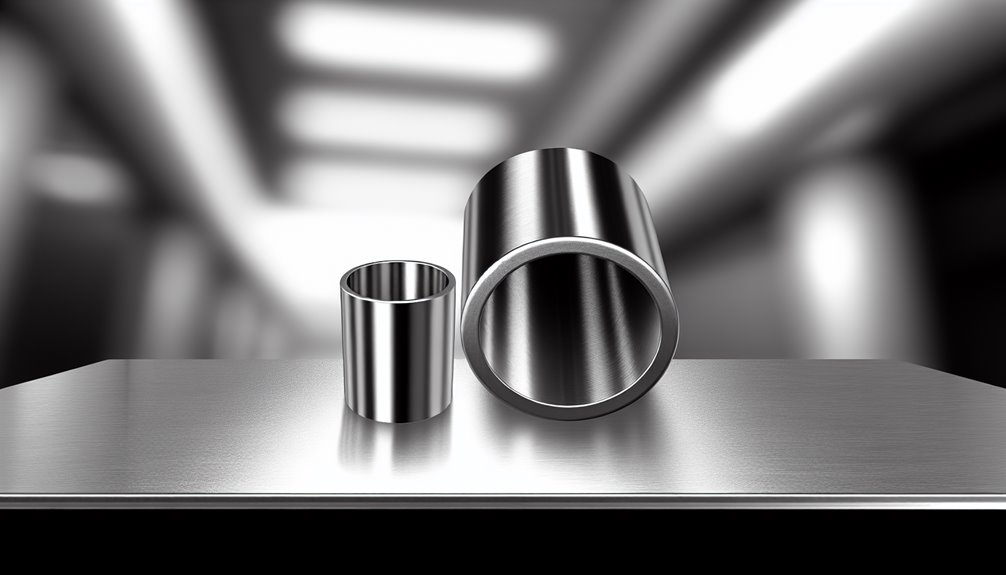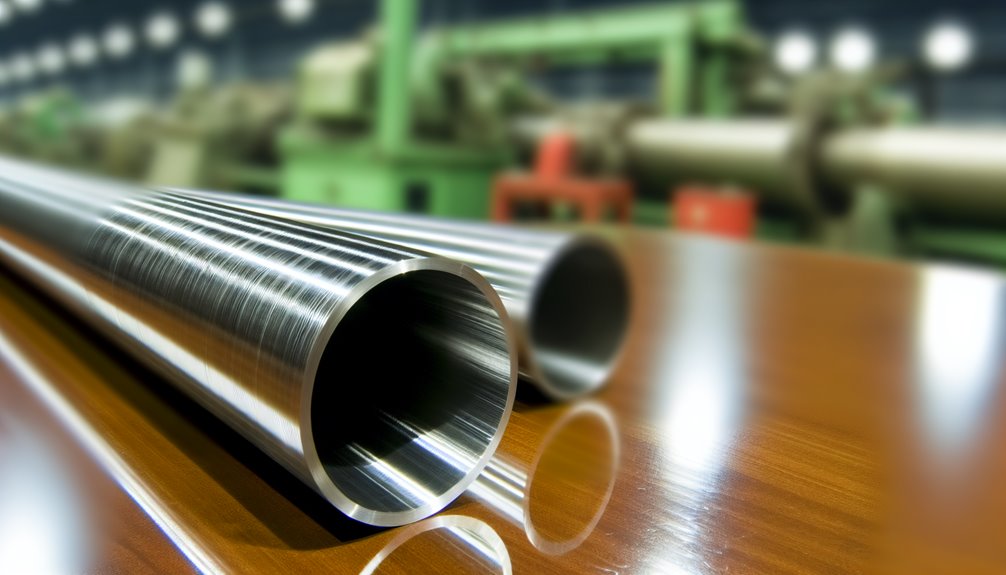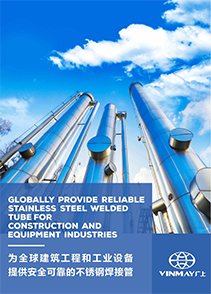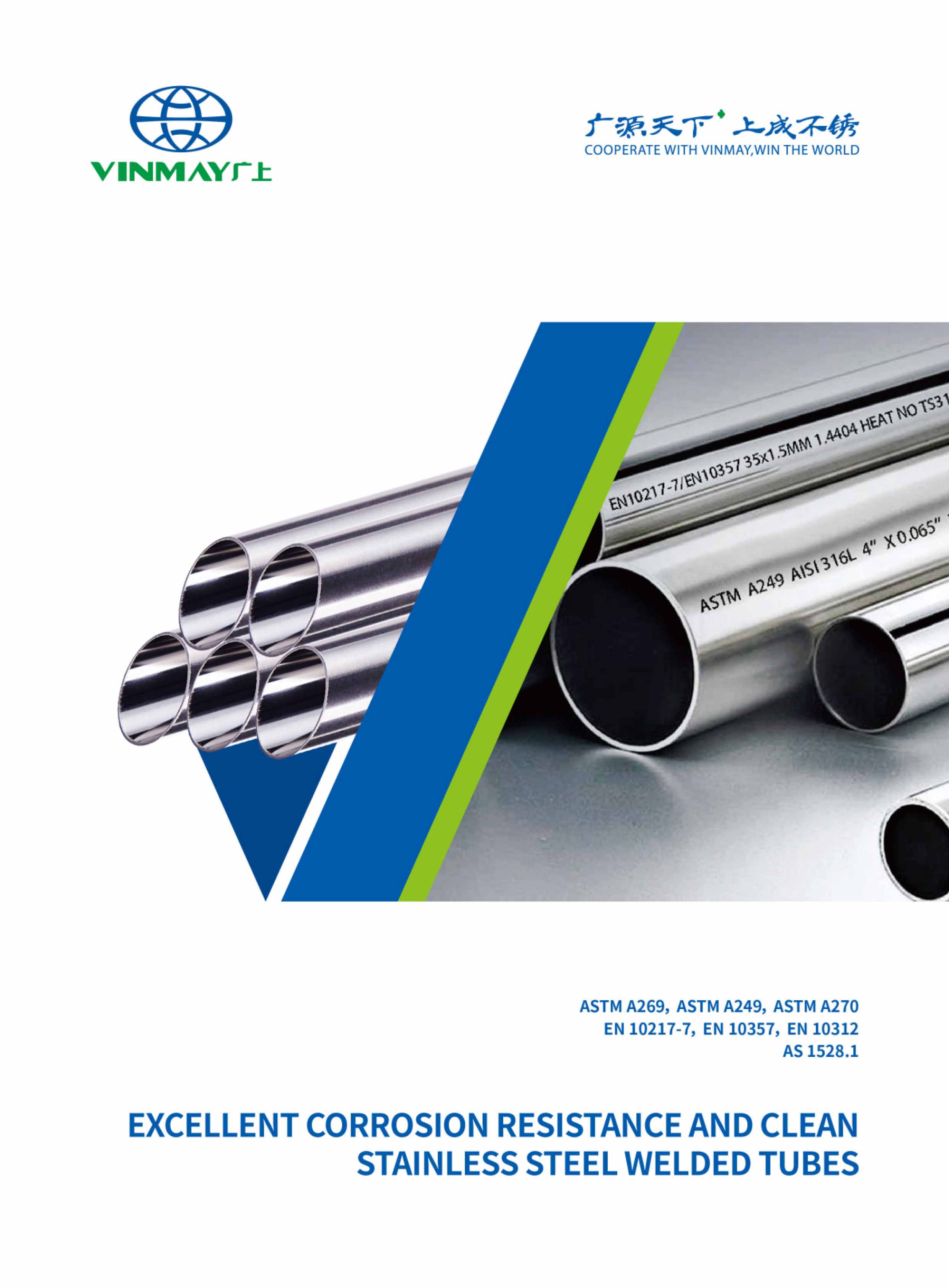When selecting stainless steel pipes, wall thickness is a critical factor that influences performance and application suitability. Thick-walled pipes are engineered for high-pressure environments, offering exceptional strength and durability, while thin-walled pipes are chosen for their lightweight nature and cost efficiency. Each type serves distinct industrial and residential needs, making the decision complex. However, choosing between thick vs thin-walled stainless steel pipe doesn't have to be complicated. Understanding these differences is essential to guarantee peak functionality and longevity, leaving one to ponder the nuances that dictate the right choice.

Several critical factors, including the intended application, pressure requirements, and environmental conditions, determine wall thickness in stainless steel pipes. The thickness influences the pipe's ability to withstand internal pressure and external forces, affecting its structural integrity.
Pipe standards, such as ASTM and ISO, provide guidelines for appropriate wall thickness, ensuring consistency and safety across applications. These standards consider variables like temperature fluctuations and chemical exposure, which can affect material performance over time.
In high-pressure environments, thicker walls are necessary to prevent failure, whereas lower-pressure settings may utilize thinner walls to optimize material use and cost efficiency. The selection of wall thickness is a calculated decision, balancing mechanical strength, durability, and compliance with industry specifications.
Thin-walled stainless steel pipes are characterized by their reduced wall thickness, which offers distinct advantages in various applications.
Their construction involves less raw material, resulting in a lightweight yet strong structure. The thin wall advantages include ease of processing and welding, making them an economical choice in both production and installation phases.
Thin-wall applications span across various fields due to their flexibility and efficiency.
Their suitability for medium and low-pressure environments highlights the practicality of thin-walled pipes in household appliances and water conduits.
Explore Stainless Steel Water Pipes

Thick-walled stainless steel pipes are engineered for high-performance environments where exceptional strength, durability, and resistance to pressure and wear are crucial. These pipes are vital in industries such as oil and gas, chemical processing, and power generation—where they reliably transport fluids, gases, and corrosive substances under extreme conditions.
Manufactured through hot drawing processes, these pipes achieve uniform wall thickness and enhanced structural integrity, ensuring they meet rigorous performance standards.
| Feature | Detail |
|---|---|
| Wall Thickness | Thicker than standard pipes |
| Manufacturing Process | Hot drawing |
| Key Applications | Oil & gas, chemical, power sectors |
The superior load-bearing capacity of thick-walled stainless steel pipes makes them indispensable for structural support and high-stress operations. Their proven ability to endure extreme environments ensures long service life and dependable performance, making them a preferred choice for engineers and design professionals worldwide.
The key differences between thick and thin-walled stainless steel pipes revolve around their production procedures, pressure resistance, thermal conductivity, flexibility, and weight.
Thick-walled pipes, typically produced through hot drawing, offer superior pressure resistance and are suitable for high-stress environments, though they have lower thermal conductivity and flexibility due to their greater mass.
Conversely, thin-walled pipes, manufactured via cold drawing, provide enhanced thermal conductivity and flexibility, making them ideal for medium and low-pressure applications while also being lighter and easier to handle.
Understanding the distinct production procedures for stainless steel pipes reveals key differences between thin-walled and thick-walled variants.
The manufacturing techniques diverge primarily due to wall thickness, influencing material properties and the methods employed. Thin-walled pipes utilize cold drawing, a technique that enhances surface finish and dimensional precision. This approach is ideal for applications requiring lightweight and corrosion-resistant properties.
Conversely, thick-walled pipes are fabricated using hot drawing, a process designed to accommodate the greater material density and guarantee structural integrity under high pressure. This method is essential for applications demanding durability and strength.
Manufacturing procedures directly influence the pressure resistance properties of stainless steel pipes.
Thick-walled pipes, characterized by greater wall thickness, exhibit higher pressure ratings and enhanced burst strength, making them suitable for high-pressure applications. This design allows them to withstand significant internal pressures without deformation or failure, essential in industries such as oil and gas.
Conversely, thin-walled pipes, with their reduced wall thickness, are more susceptible to pressure-induced deformation, limiting their use to medium and low-pressure environments. The pressure ratings of thin-walled pipes are inherently lower, restricting their application in scenarios demanding high burst strength.
Therefore, the choice between thick and thin-walled stainless steel pipes should be informed by specific pressure requirements and operating conditions to guarantee structural integrity and safety.
When examining the thermal conductivity properties of stainless steel pipes, especially in the context of thick versus thin-walled variants, significant differences emerge.
Thin-walled stainless steel pipes generally exhibit superior thermal efficiency due to their lower mass, which facilitates quicker heat transfer. This characteristic enhances their insulation performance, making them ideal for applications requiring minimal heat loss.
In contrast, thick-walled pipes possess greater thermal mass, leading to slower heat transfer rates, which could be advantageous in scenarios requiring thermal stability.
Importantly, the disparity in thermal conductivity also impacts energy consumption and system efficiency.
Flexibility and formability are critical attributes distinguishing thick-walled from thin-walled stainless steel pipes.
Thin-walled pipes exhibit superior formability advantages due to their reduced thickness, allowing for easier bending and shaping in applications requiring intricate designs or curvatures. This attribute is beneficial in manufacturing processes where precision and adaptability are paramount.
Conversely, thick-walled pipes, while offering enhanced structural integrity, present challenges in flexibility considerations. Their robust construction limits the capacity to bend or shape without employing specialized equipment and techniques.
The formability advantages of thin-walled pipes make them ideal for applications where rapid and precise fabrication is necessary, while thick-walled variants serve environments demanding durability over flexibility. Each type provides specific benefits tailored to its respective operational conditions.
The weight of stainless steel pipes is a critical factor in differentiating between thick-walled and thin-walled variants, impacting their application and performance. Analyzing the weight implications reveals significant distinctions in their structural and functional attributes.
Understanding these weight comparisons allows decision-makers to allocate resources efficiently, ensuring peak performance across various engineering applications.
Such insights are pivotal for selecting the appropriate pipe type based on specific operational demands and constraints.
Although both thick-walled and thin-walled stainless steel pipes serve essential roles in various industries, their cost structures differ markedly due to their physical characteristics and material requirements.
Thick-walled pipes, utilizing a greater quantity of raw material, inherently reflect higher upfront costs. However, their robustness and durability can translate into long-term cost efficiency, particularly in high-pressure and demanding environments.
Conversely, thin-walled pipes exhibit lower initial costs due to reduced material usage, offering a lightweight alternative for applications with moderate pressure requirements.
This price comparison reveals that while thin-walled options may present immediate economic advantages, the overall expenditure should be evaluated against the operational demands and longevity expectations of the specific application, ensuring best resource allocation and financial planning.
Related Article: Understanding Stainless Steel Tube Costs
Many factors contribute to the installation difficulty of stainless steel pipes, with wall thickness being a significant determinant.
Installation techniques and installation challenges differ markedly between thick and thin-walled pipes. Thicker pipes present challenges due to their weight and rigidity, requiring specialized equipment and expertise. Conversely, thin-walled pipes are lighter and more flexible, yet susceptible to deformation during handling and installation.
Understanding these aspects allows for informed decision-making, ensuring ideal pipe performance and longevity in diverse applications.
In situations where durability and resistance to high pressure are paramount, thick-walled stainless steel pipes find their niche.
These pipes, known for their robust material durability, are extensively utilized in industrial applications requiring reliable performance under stress. Their thicker walls provide exceptional load-bearing capacity, making them an ideal choice for high-pressure environments such as oil and gas transportation, where the risk of breakage must be minimized.
Thick-walled stainless steel pipes excel in high-pressure settings, ensuring durability and minimizing breakage risks.
Additionally, the 304 thick-walled variant is specifically suitable for nuclear energy, offering resilience against extreme conditions.
In chemical processing, these pipes are indispensable for transporting corrosive chemicals safely.
The food processing industry also benefits, as thick-walled pipes guarantee sanitary transportation of products, adhering to stringent hygiene standards, and maintaining operational integrity in demanding scenarios.

Thin-walled stainless steel pipes emerge as a versatile solution across various domains, particularly in applications where lightweight and corrosion resistance are essential.
These pipes are extensively used in both industrial applications and residential uses, offering distinct advantages in various settings. Their adaptability is evidenced in:
In hospitals, schools, and homes, 304 thin-walled stainless steel pipes are preferred for their reliable performance, meeting stringent safety and efficiency standards.
Selecting the appropriate pipe wall thickness is essential for ensuring both the structural integrity and operational efficiency of piping systems.
Pipe selection hinges on evaluating factors such as pressure requirements, environmental conditions, and material properties. For high-pressure applications, thicker walls provide the necessary strength to withstand internal forces, whereas thin-walled pipes excel in scenarios demanding flexibility and thermal efficiency.
Wall thickness directly impacts a pipe's weight, cost, and ease of installation, with thicker pipes generally requiring more robust support structures and installation techniques.
Additionally, understanding the medium being transported—whether it's corrosive, hot, or involves high flow rates—is significant.
Ultimately, meticulous analysis of operational demands and environmental conditions will guide the precise determination of suitable wall thickness for ideal performance and reliability.
Temperature affects stainless steel pipe wall thickness like a sculptor's chisel, through thermal expansion and heat resistance. Elevated temperatures cause expansion, potentially altering thickness, while stainless steel's heat resistance mitigates deformation, maintaining structural integrity under controlled conditions.
The cost comparison between thick and thin-walled pipes involves price factors like raw material usage, manufacturing complexity, and application requirements. Thick pipes generally incur higher costs due to increased material and processing demands, impacting overall pricing structure.
The environmental impacts of using thick-walled pipes include sustainability concerns due to increased resource usage. Although they offer durability, their production demands more raw materials, raising questions about resource efficiency and carbon footprint in manufacturing processes.
Installation methods, with welding techniques as the keystone, differ considerably due to material characteristics. Thick-walled pipes present more installation challenges, requiring robust equipment, while thin-walled pipes demand precise handling to maintain integrity and avoid deformation.
Thin-walled pipes exhibit limited seismic resistance due to their flexibility. Their structural integrity under seismic forces may be compromised, necessitating additional support systems or materials to enhance performance and guarantee stability during seismic events.
In weighing the pros and cons of thick-walled versus thin-walled stainless steel pipes, one must consider the specific demands of the application at hand. Thick-walled pipes are the go-to solution for high-stress environments, ensuring robust durability and pressure resistance. Conversely, thin-walled pipes offer a lightweight, cost-effective alternative for less demanding scenarios. Ultimately, the choice boils down to a trade-off between strength and efficiency, so it's essential to measure twice and cut once when selecting the appropriate pipe wall thickness.



